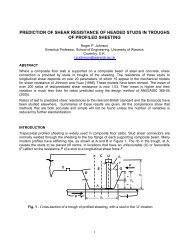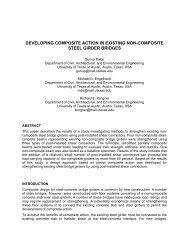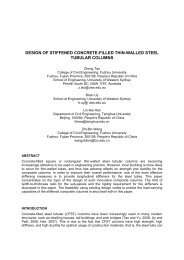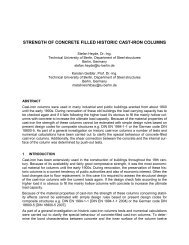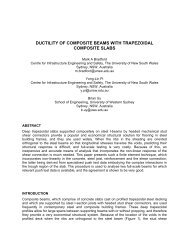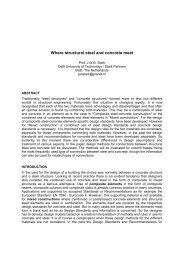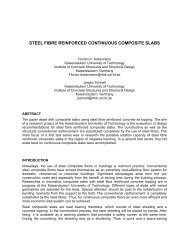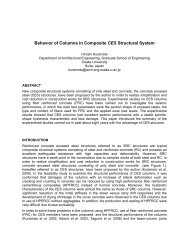concrete - filled steel tube columns - tests ... - CCVI Information
concrete - filled steel tube columns - tests ... - CCVI Information
concrete - filled steel tube columns - tests ... - CCVI Information
You also want an ePaper? Increase the reach of your titles
YUMPU automatically turns print PDFs into web optimized ePapers that Google loves.
2.001.75Ratio Test / EC41.501.251.000.75Circular Circ. + preload Short Rect.Long Rect. Rect. + preload Rect. + sus. load0.500.0 0.2 0.4 0.6 0.8 1.0 1.2 1.4 1.6Slenderness = SQRT(Npl.Rk/Ncrit)Figure 7. Columns with moment. Ratio Test/EC4 against SlendernessHollow sections (rows 10 and 14 in Table 1)Hollow sections were formed by spinning the <strong>steel</strong> <strong>tube</strong> with some <strong>concrete</strong> in it so thatcentrifugal force leaves a hole in the <strong>concrete</strong>. All the hollow sections used low strength<strong>concrete</strong>, none greater than 40 N/mm 2 , and gave column strengths about 20% greater thanpredicted. This may be due to the difficulty of measuring the true strength of the spun <strong>concrete</strong>which might be higher than the measured cylinder strength. However, it appears that hollowsections can be designed safely using Eurocode 4 if the hole is allowed for.Preload and sustained load (rows 11, 12, 13 in Table 1)Pre-load (up to 60% of the capacity of the <strong>steel</strong>) on the <strong>steel</strong> <strong>tube</strong> before filling with <strong>concrete</strong>seems to have had no effect on the strength; the average Test/EC4 for the 23 circular <strong>columns</strong>(11 short and 12 long) being 1.15 (SD 0.123) and for the 19 rectangular <strong>columns</strong> (10 short and12 long) being 1.03 (SD 0.099). The eight <strong>tests</strong> which sustained an average load of between53% and 63% of their capacity for 120 or 180 days before being loaded to failure carried aslightly higher load before failing (average Test/EC4 = 1.25) than their six comparison <strong>tests</strong>without sustained load (average Test/EC4 = 1.08); these six companion <strong>tests</strong> are included in the212 <strong>tests</strong> of row 6 of Table 1.Biaxial bendingOnly eleven <strong>tests</strong> on rectangular <strong>columns</strong> with biaxial bending are reported and these all failedat much higher loads than predicted by Eurocode 4, average Test/EC4 was 1.52. The Codeuses a straight line interaction for the bending resistance between the two axes with anadditional safety factor α M , (with α M as 0.9 for <strong>steel</strong> grades S235 to S355 and 0.8 for <strong>steel</strong>grades S420 and S460, Clause 6.7.3.7). Using an elliptical interaction between the momentsabout the two axes and omitting this additional safety factor, ie. α M = 1, gives much closeragreement with the test failure load, an average Test/Prediction of 1.20 for these eleven <strong>tests</strong>;see the last two rows of Table 1.




